In the early years of the 17th century, the formidably intelligent Lady Anne Bacon Drury set about devising, and perhaps even painting for herself, a group of 61 panels for a private closet at Hawstead House in Suffolk. Lady Drury is now best known as a patron of John Donne, but her extraordinary closet, housed in Christchurch Mansion in Ipswich since 1924, demonstrates her significance in her own right. The panels present a series of prompts for meditation: scenes and symbols are glossed with mottos to provide moral lessons, often concerned with the right use of the senses for spiritual and moral ends. One panel in particular foregrounds the relationship between the senses, identity, and visual art. In a strange landscape, a painter resembling Lady Drury’s brother, the accomplished amateur artist Sir Nathaniel Bacon, sits at an easel painting a portrait, but a sitter is nowhere to be seen. A small banderole at the bottom of the panel addresses the half-finished portrait: Dic mihi, qualis eris? (tell me, what will you be?).
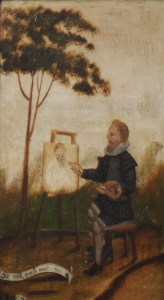
Panel from Lady Drury’s Closet, early 17th century. Christchurch Mansion, Ipswich Museums
It is not clear exactly what this panel would have meant to Lady Drury. The motto is adapted from Martial’s Epigram XII.92, where the question is addressed to a character called Priscus and concerns the inconstancy of human character when exposed to changing circumstances. In the spirit of adaptation and reinvention typical of early modern English culture, however, Lady Drury’s panel addresses Martial’s question, not to a person, but to a picture. Renaissance literature scholar Jane Partner reads this as ironic, echoing a theme found in several other panels: appearances are untrustworthy, incapable of revealing a person’s true character. On the other hand, Heather Meakin, author of the most comprehensive study of the panels to date, suggests that the panel expresses some confidence in the ability of worldly things, when rightly interpreted, to reveal inner truth. In this view the questioner (whether identified as the painter or as Lady Drury herself) is in earnest, the portrait believed to be in some sense capable of answering back.
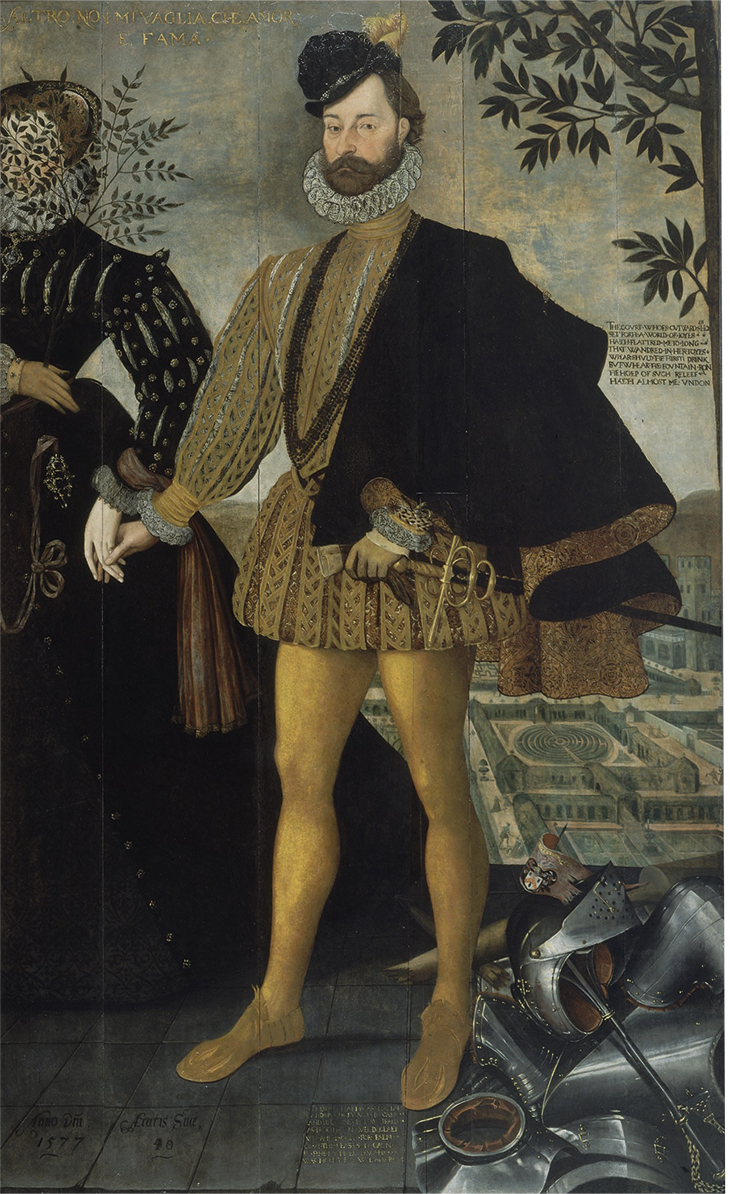
Portrait of George Delves and a Female Companion (1577), unknown artist (British school). Walker Art Gallery, Liverpool. Image courtesy Walker Art Gallery
In fact, a surprising number of images and objects in the 16th and 17th centuries appear capable of exercising the power of speech, whether through inscriptions or other communicative techniques. To the majority of well-educated contemporaries, however, a ‘speaking picture’ wasn’t a picture at all, but poetry. As Philip Sidney wrote in his Apologie for Poetrie (c. 1580): ‘Poesie therefore, is an Art of Imitation […] A speaking Picture, with this end, to teach and delight.’ Sidney uses the metaphor, itself derived from classical maxims, to evoke poetry’s ability to conjure vivid mental images. But Sidney’s phrasing also suggests a certain superiority: real pictures are silent and only poets can make them speak. This view would have found favour with many Protestant preachers. As churches were being whitewashed and Catholic imagery eliminated, reformers were anxious to remind their congregations that images, at least in controversial religious contexts, were ‘dumb’, incapable of communication. ‘[O]ur Images […] be dead and dumb works of man’s hands, having mouths and speak not […]’ writes John Jewel in the ‘Homily Against Peril of Idolatry’ (1571), riffing on Psalm 115.
Despite religious scepticism about the power of visual culture to communicate, everywhere in Tudor culture we find pictures that seem to speak. In portraits, for example, inscriptions in the first person seem to put words into sitters’ mouths. George Gower’s self-portrait of 1579 presents the artist, who was born into the gentry, holding a palette in his hands. A balance hovers near his shoulder, weighing a pair of compasses (representing the geometrical foundations of his painterly craft) against his coat of arms. A verse written in the first person explains the emblem:
Though youthful ways me did entice from arms and virtue eke [also] / Yet thanked be God for his good gift which long did rest asleep. / Now skill revives with gain, and life to lead in rest / By pencil’s trade, wherefore I must, esteem of it as best / The proof whereof these balance show, and arms my birth displays / what Parents bare by just renown, my skill maintains the praise / And them whose virtue, fame and acts, have won for me this shield / I reverence much with service eke, and thanks to them do yield.
In fact the balance shows the compass outweighing Gower’s coat of arms, suggesting he attached more importance to skill than to inheritance. Nevertheless, the verse allows Gower’s image to address viewers as if they were in his presence. This technique can also be found in Portrait of George Delves and a Female Companion (1577), where inscriptions speak of surrendering the ‘toys’ of a court that ‘hath flattered me too long’, and in Marcus Gheeraerts the Younger’s Portrait of an Unknown Woman (c. 1590–1600), where the sitter glosses her portrait’s complex melancholic symbolism in a sonnet: ‘The restless swallow fits my restless mind […] With pensive thoughts my weeping Stag I crown.’
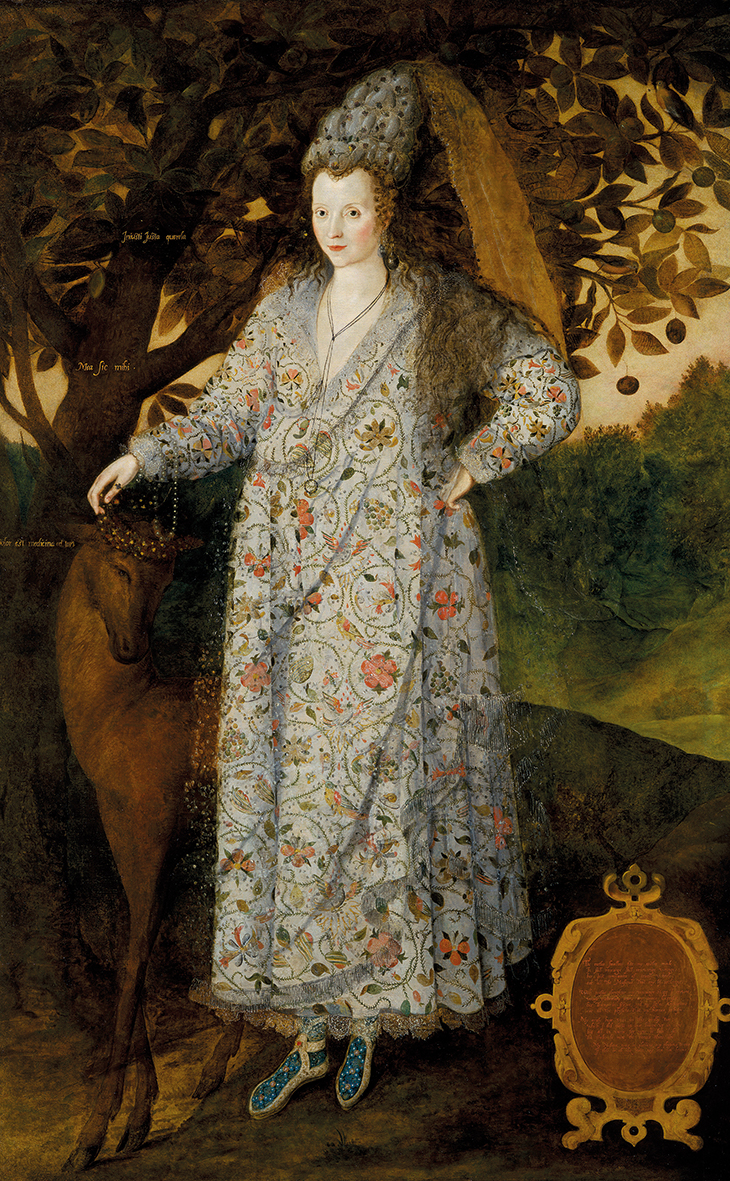
Portrait of an Unknown Woman (c. 1590–1600), Marcus Gheeraerts the Younger. Photo: Royal Collection Trust/© HM Queen Elizabeth II 2021
The phenomenon of the speaking portrait has a literary parallel. Prosopopoeia, from the Greek prosopon (face, person) and poiein (to make, to do) is the attribution of speech to imagined people or inanimate objects. This technique comes under the classical art of rhetoric: a core subject in the early modern school curriculum and one that shaped the mental habits of generations of readers and viewers both consciously and unconsciously. In ancient rhetorical theory prosopopoeia was often associated with grand subjects, as orators brought cities, nations and gods to life, to exhort or reproach their audiences in the courtroom or the senate. In the later 16th century, however, domestic objects were equally likely to be personified. In c. 1599, the poet and scholar John Hoskins cited the example of Philip Sidney’s New Arcadia (1590), in which the author ‘gives meaning and speech to the needle, the cloth and the silk’:
[Pamela’s needle] with so pretty a manner made his careers to and fro through the cloth, as if the needle itself would have been loath to have gone fromward such a mistress, but that it hoped to return thenceward very quickly again: the cloth looking with many eyes upon her, and lovingly embracing the wounds she gave it: the shears also were at hand to behead the silk, that was grown too short.
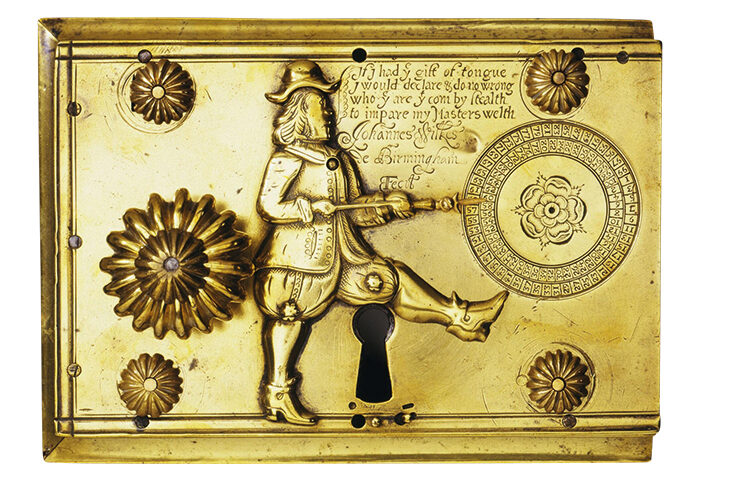
Detector lock (c. 1680), John Wilkes. Victoria and Albert Museum, London
Sidney attributes thoughts and desires to these everyday objects. Yet such playfulness was not limited to literature: surviving objects suggest a widespread enthusiasm for making ‘things’ speak, one that continued long into the next century. A knitting sheath in the Victoria and Albert Museum, designed to be attached to the waist, allowing its owner to knit one-handed, addresses its owner much as Pamela’s needle might have addressed her: ‘I am box and brass within / My place is on your apron string’. The sheath, initialled and dated ‘AT 1679’, suggests either friendly companionship (indeed any amateur knitter might sympathise with the feeling that the implements have a life of their own), or a more sinister kind of admonishment and surveillance: you should be knitting. The threat of observation is found in an almost exactly contemporary detector lock by John Wilkes, also in the V&A, whose dial allows the owner to see whether the lock had been opened in their absence, and whose inscription promises the would-be thief: ‘If I had ye gift of tongue / I would declare & do no wrong / who ye are that come by stealth / to impair my Masters wealth’. An example in the Rijksmuseum features no such reproach, while another sold at Sotheby’s in 2015 substitutes ‘Masters’ for ‘Ladys’ in an otherwise identical inscription, suggesting an element of personalisation.
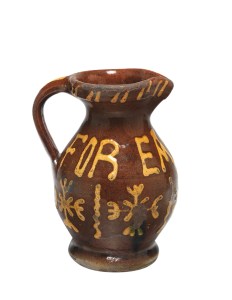
Jug (17th century), Harlow, Essex (?). Fitzwilliam Museum, Cambridge.
Inscriptions and epigrams were scattered throughout the early modern home, on walls, furniture and portable objects. Their admonitory potential no doubt formed part of their attraction for householders seeking to discipline family members, servants, and themselves. Not all such inscriptions were in the first person. Wall paintings in the Painted Room in 3 Cornmarket, Oxford, formerly the Bull Inn (where Shakespeare is believed to have stayed), include a frieze filled with religious precepts: ‘In the morning early / Serve god Devoutly’ and ‘Fear god above all thing’, clearly intended to keep the inhabitants’ minds on higher matters as they went about their daily lives. Inscriptions didn’t have to be religious; some were generally moralising, or simply amusing, and publications were issued providing ready-made phrases for different parts of the home. Thomas Tusser’s Five Hundred Points of Good Husbandrie (1573 and many subsequent editions) offered mottos promoting friendship and good relations (‘Hast thou a friend, as heart may wish at will? / Then use him so, to have his friendship still’) and doggerel ‘for the guest’s chamber’ that reads like a list of hotel rules (‘The sloven and the careless man, the roynish [coarse] nothing nice / To lodge in chamber comely decked, are seldom suffered twice’). Even among today’s rare survivals, maxims from Tusser have been found in wall paintings at multiple locations, suggesting their enormous popularity.
This vogue for walls with painted or carved inscriptions has sometimes been identified with the early modern practice of commonplacing. Grammar school students were encouraged to collect phrases from their reading in a commonplace book, to be deployed in their own compositions. Many adults also kept commonplace books and historians such as Christy Anderson and Andrew Morrall have compared this habit with the proliferation of inscriptions in domestic interiors. The limited evidence for the use of such inscriptions in practice bears this out. Morrall cites the funeral oration for Lady Anne Clifford, given in 1676:
She would frequently bring out of the rich Store-house of her memory, things new and old, Sentences, or Sayings of remark, which she had read or learned out of Authors and with these her Walls, her Bed, her Hangings, and furniture must be adorned; causing her Servants to write them in Paper, and her Maids to pin them up, that she, or they, in time of their dressing, or as occasion served, might remember, and make their descants upon them.
Like a student deploying a choice phrase from her commonplace book, Lady Clifford ‘made her descants’ upon the phrases that decorated her chambers. In so doing, she turned her environment into a real-life ‘memory palace’, prompting her to meditate on the wisdom of past authors and apply it to her own life.
Yet the speaking object emerges from a deeper place in the medieval and early modern psyche than educational conventions. According to Christian theology, nature, God’s ‘second book’, contains moral lessons: ‘For the invisible things of him from the creation of the world are clearly seen, being understood by the things that are made, even his eternal power and Godhead’ (Romans 1:20). With careful interpretation, things in the world could offer spiritual lessons. This belief justified the practice of emblematics: images could be glossed with mottos to reveal the truths hidden within them – as witnessed in Lady Drury’s Closet. Inscriptions aided in the spiritualisation of the environment by making the lessons contained in everyday things explicit. Far from being simply a vehicle for any old ancient aphorism, matter had morals of its own to offer.
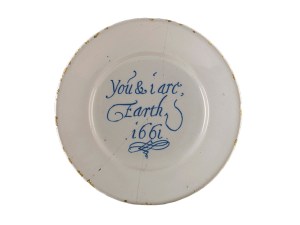
Plate (1661), excavated in London, Museum of London. Photo: © Museum of London
We see this particularly in ceramics: a slipware jug in the Fitzwilliam Museum inscribed ‘for Earth I Am’; the earthenware plate recovered from a London sewer that reads ‘You and i are Earth 1661’, and, more prosaically, the Metropolitan ware chamber pot in Stoke-on-Trent Museum, dated 1656 and inscribed ‘Eart I am et tes most tru des da/n me not for so ear you’ (earth I am it is most true, disdain me not for so are you). The inscriptions allude to human mortality, the clay pots figuring the body originally made by God ‘of the dust of the grounde’ (Genesis 2:7). Even without words the material world could be made to signify these deeper truths: Bartmannkrüge or ‘face jugs’ were bottles with bearded faces and sometimes chests and arms moulded on to them. Mostly made in the Rhineland and imported, they were so popular with English audiences that German potters started to include English heraldry on some examples as a matter of course.
Literary theorist Juliet Fleming has described the ‘poetic burden of early modern crockery’: the natural affinity between the brittle human body and the vessel of clay. The metaphorical comparison of human bodies to ceramic pots is an ancient one: urns with faces have been found dating as far back as the fourth millennium BC, while Roman face pots are a famous example of the practice. To a Christian audience in the 16th and 17th centuries, the speaking jugs and Bartmannkrüge would have recalled 2 Corinthians 4:7, ‘But we have this treasure in earthen vessels, that the excellency of the power may be of God, and not of us.’ Encountering these objects as they went about their day, the godly Tudor viewer may well have paused to meditate on their own mortality and their soul’s fate in the hereafter.
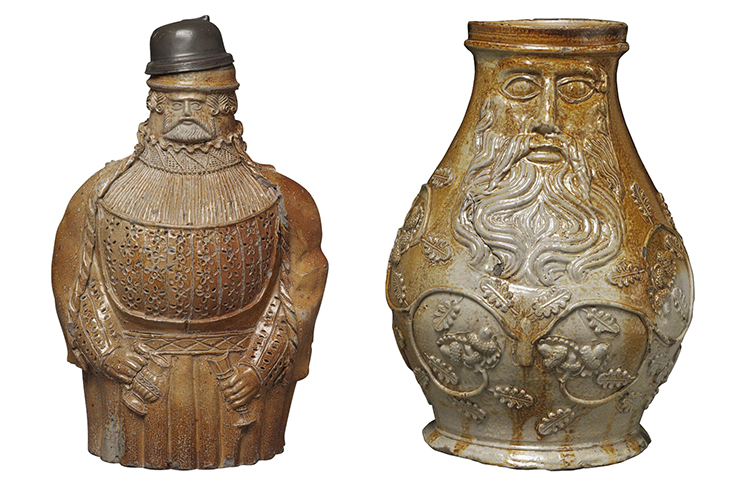
(Left) ‘Bartmann’ jug (c. 1525–50), Cologne; (right) ‘Bartmann’ jug (c. 1540), Cologne, both Victoria and Albert Museum, London
But there is also something delightful about the portly seriousness of face jugs. For all their weighty moralising, speaking objects have a playfulness about them. While it might be argued that their inscriptions reveal a lack of confidence in the ability of matter to communicate meaning by itself, in practice the open-ended relationship between text and image encouraged, rather than circumscribed, interpretation. In this sense, it is not merely the portrait in Lady Drury’s panel that is addressed by the question ‘Tell me, what will you be?’ but the whole closet: even the whole visual world. Speaking objects – whether portraits, jugs or wall paintings – offered a kaleidoscope of moral instruction and spiritual truth in which the physical world seemed almost to be an active participant.
But what of speech itself? Even this had its dangers, as Lady Drury knew all too well. In the panel diagonally below that of the painter at his easel is a more sinister creature. A pink mass with a long, knotted, lizard tail seems to strive upwards on ragged wings: a lumpen flight that takes it no higher than a nearby sapling. Beneath, a motto on painted paper reads Quo tendis? (Where are you going?) The pink thing is a tongue, the panel a version of a popular emblem about the dangers of unbridled speech. But there is another reason why the early modern viewer might have asked Quo tendis? Loosed from the body, the tongue has no larynx to aid it, and no mind to supply it with thoughts. Authors such as William Scott argued that, without a picture or ‘body’ to accompany it, the word was but ‘an idle, fantastical air that hath no sensible existence, that cannot move the sense’ (Model of Poesy, 1599). Pictures may have needed words, but to make moral lessons delightful and memorable, words needed pictures too.
From the June 2021 issue of Apollo. Preview and subscribe here.
Unlimited access from just $16 every 3 months
Subscribe to get unlimited and exclusive access to the top art stories, interviews and exhibition reviews.

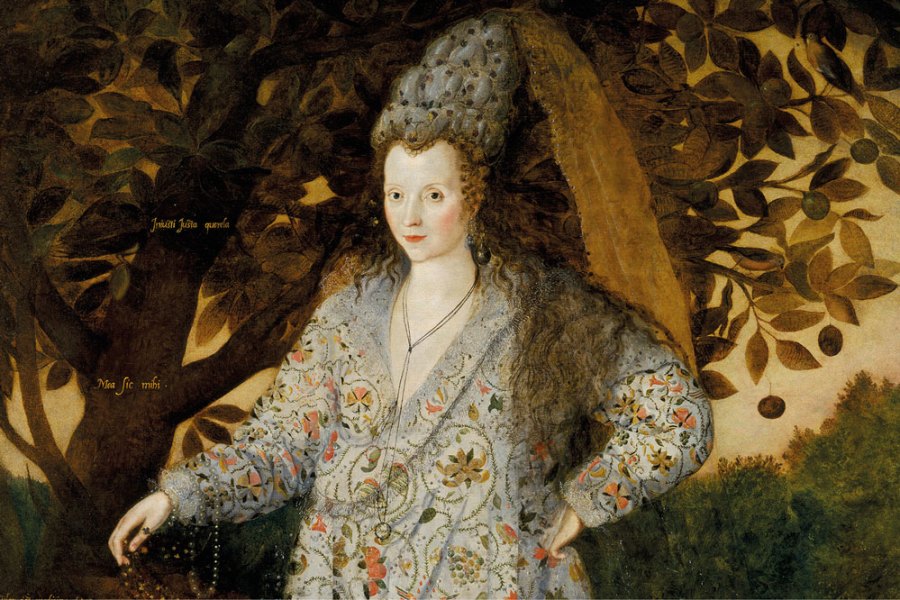
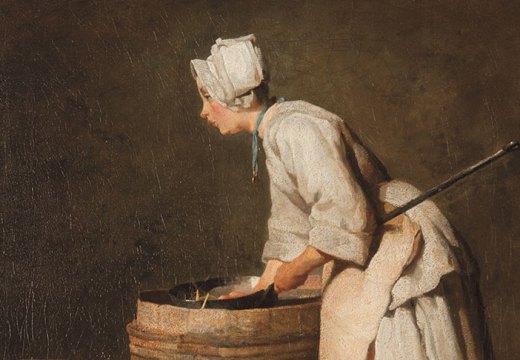
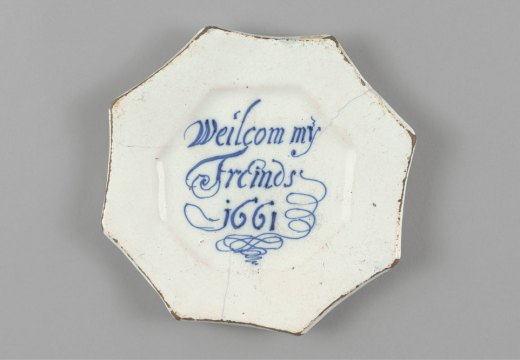
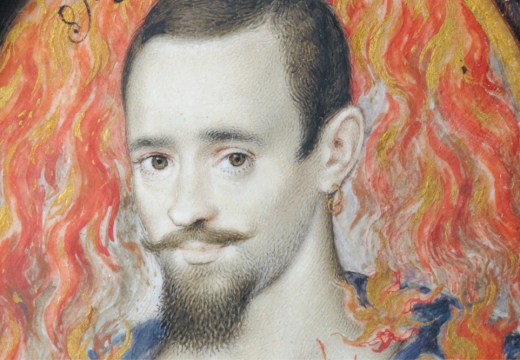









![Masterpiece [Re]discovery 2022. Photo: Ben Fisher Photography, courtesy of Masterpiece London](http://www.apollo-magazine.com/wp-content/uploads/2022/07/MPL2022_4263.jpg)
It’s time for the government of London to return to its rightful home